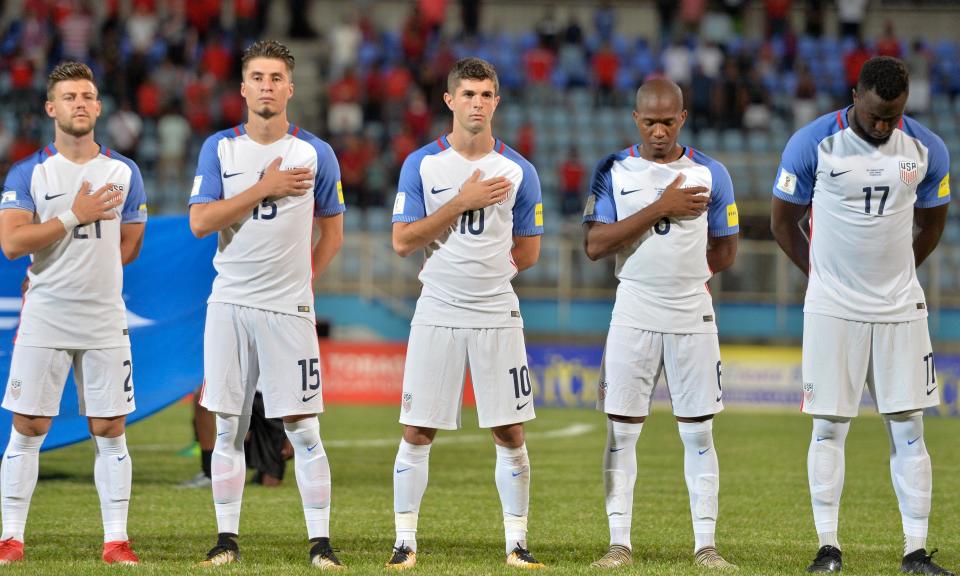2017 was a bad year for the USMNT, but it also wasn't unusual

So 2017 was a weird year for the United States men’s national team, which finished up its slate with a hopeful 1-1 tie with Portugal on Tuesday.
It won the Gold Cup, yet it also failed to qualify for the World Cup for the first time since 1986. It cobbled together an undefeated run of 14 games. The Americans didn’t lose a match until Sept. 1, and dropped just two games all year, for a very solid 10-2-7 record.
Yet the entire campaign was a terrible failure. Because those two losses came in crucial World Cup qualifiers. The 2-0 home defeat to Costa Rica in New Jersey was embarrassing yet somewhat comprehensible — a bad day. The 2-1 away loss to Trinidad and Tobago, which conspired with other results to prevent the U.S. from going to an eighth straight World Cup, was downright calamitous and inexcusable.
Here are some other weird factoids about the USMNT in the past year:
— The senior men’s national team’s leading scorer for 2017, Christian Pulisic with six goals, was 18 years old for most of the year.
— This was the first time in men’s national team history that a full-time manager was fired or resigned in back-to-back years. Jurgen Klinsmann was let go in late 2016, after a disastrous start to qualifying. And Bruce Arena left when he fell just short of turning qualification around in October.
— The U.S. came in fifth out of six teams in the final round of CONCACAF qualifying yet led the region in scoring with 17 goals in 10 games. (Its 13 goals conceded were also the third-most.)
The thing of it is, it seems all of the recent years have been strange ones for the USA. In 2016, the Americans got off to the aforementioned horror start in the final round of qualifying but went undefeated in its seven friendlies, winning six — against admittedly meek opposition. That year, they also showed unexpectedly well in the Copa America Centenario on home turf, reaching the semifinals before getting thrashed by Argentina.
In 2015, Klinsmann’s side had a shaky year, running up a 10-6-4 record and failing to reach the Confederations Cup in a winner-take-all playoff with Mexico — while the under-23s didn’t make it to the Rio Olympics on the very same day. But in the middle of all this mediocrity, the Americans beat Mexico, world champions Germany and a Netherlands side coming off a third-place finish at the World Cup, in consecutive friendlies.
Ahead of the 2014 World Cup, the U.S. reeled off impressive friendly wins over Azerbaijan, Turkey and Nigeria. But once it arrived in Brazil, it largely forgot how to play soccer. Still, the Yanks stole a win from Ghana; forgot to close out a win against Portugal, settling for a tie; and lost to a Germany side on cruise control. It then got clobbered by Belgium in the Round of 16, somehow hanging on into extra time. That was seen as a good performance, since the U.S. had survived a fairly tough group, which, in retrospect, wasn’t nearly as deathly as Group A (Spain, Netherlands, Chile, Australia) or Group D (Uruguay, England, Italy, Costa Rica).
Remember 2013? Klinsmann had an all-out revolt on his hands when a slew of his players complained about him anonymously to Sporting News after another poor start to qualifying. The U.S. won just one of its first five games of the year. But then it unspooled a record 12-game winning streak, claiming 15 victories in 16 consecutive games and cruising to a Gold Cup win and qualification for Brazil.
The point is … well, you get the point.
The U.S. national team has hardly ever had a consistent year. Part of that is due to the swings inherent in international soccer, and indeed sports as a whole. Some of it is because the U.S., like all soccer countries that are strong in a weak region but average on a global level, is forever adjusting between playing down to CONCACAF minnows and up to world powers.
It’s just that in years past, the downswings came at more convenient times, rather than when a spot at the World Cup — the only time when failure was absolutely irredeemable — was on the line. And many of the upswings were fortuitously timed, perhaps suggesting more progress in the program than was actually there. It’s all hard to say, exactly.
Broadly, inconsistency is to be expected from a team that still has a lot of upward mobility left to make good on. The U.S. isn’t just playing for results, it’s still trying to get better at soccer — or at least the kind of soccer that’s more likely to help it win things in the decades to come. So long as that’s the case, outcomes are going to be uneven. Even more so than the natural cycle of player primes and performance would dictate.
If there was an overarching lesson to be taken from 2017, it is that the road up the mountain is never straight, and seldom smooth.
Leander Schaerlaeckens is a Yahoo Sports soccer columnist and a sports communication lecturer at Marist College. Follow him on Twitter @LeanderAlphabet.
More from Yahoo Sports:
• Vice president’s Colts stunt cost police $14K, showed ‘disregard for ethics’
• President Trump wants a thank-you from the UCLA Three
• Halladay’s widow delivered a brave and emotional eulogy for her husband
• Chris Mannix: Timberwolves’ defense still lacking teeth



